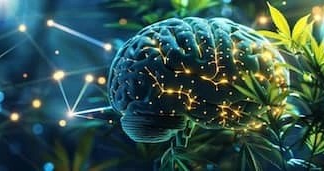What are Cannabinoids and what are their effects?
Author: Pavel Cermak
Cannabinoids (CBD) are a group of compounds found in the plant kingdom, particularly in cannabis and a few other plants. Discover more about the different types of cannabinoids and their effects.
The most well-known Cannabinoids
The most recognized cannabinoids include THC (tetrahydrocannabinol), CBD (cannabidiol), CBN (cannabinol), CBC (cannabichromene), and CBG (cannabigerol). Here, you can find additional information about the top 10 most significant cannabinoids and their effects.
THC is the primary psychoactive compound in cannabis. However, in industrial hemp, this compound is almost absent, as its content is limited to a maximum of 0.2% according to EU regulations.
THC
Delta-9-tetrahydrocannabinol, commonly known as THC, is the most well-known and widely present cannabinoid in cannabis. It is responsible for the primary psychoactive effects experienced when consuming cannabis. THC stimulates parts of the brain that cause the release of dopamine, inducing a feeling of euphoria and well-being. Additionally, THC has analgesic properties and helps alleviate symptoms of pain and inflammation, leading to a profound sense of relaxation.
Medical Benefits of THC:
- Alzheimer’s disease
- Neuropathic pain
- Multiple sclerosis
- Parkinson’s disease
- Post-traumatic stress disorder (PTSD)
- Cancer
- Crohn’s disease
CBD
Cannabidiol, abbreviated as CBD, is the second most common cannabinoid found in cannabis. It has significant medical uses and is highly sought after by healthcare professionals. CBD is non-psychoactive and is valued for its ability to reduce and regulate the effects of THC. After the media discovered CBD’s therapeutic potential, it sparked a wave of cannabis research. Here are some of the conditions treatable with CBD:
Medical Benefits of CBD:
- Epilepsy
- Cancer
- Depression
- Anxiety
- Psychotic disorders
- Chronic pain
- Diabetes
CBN
Cannabinol, known as CBN, is formed as a result of the breakdown or oxidation of THC. It is mildly psychoactive and is found only in small amounts in fresh cannabis plants. The amount of CBN can be minimized by storing harvested cannabis in a dark, dry place. Although THC's effects are preferred over CBN, CBN still has some important medicinal properties.
Medical Benefits of CBN:
- Appetite stimulation: Studies show CBN significantly increases appetite in rats.
- Antibiotic properties: CBN is effective against antibiotic-resistant MRSA infections.
- Potential ALS treatment: CBN may delay the onset of symptoms in neurodegenerative diseases.
- Pain relief: CBN has strong analgesic effects.
- Anti-asthmatic effects: CBN shows anti-inflammatory properties and may alleviate allergic asthma.
- Sedative: CBN has a potent sedative effect.
- Possible glaucoma treatment: CBN may reduce intraocular pressure.
CBG
Cannabigerol, or CBG, is a compound in cannabis known mainly for its antibacterial effects. Recent studies have shown that CBG is the precursor or "stem cell" for THC and CBD, as these cannabinoids originate from CBG.
Medical Benefits of CBG:
- Antibiotic: CBG has strong antibacterial properties and is effective against MRSA.
- Potential psoriasis treatment: CBG shows therapeutic potential for skin conditions like psoriasis.
- Pain relief: CBG is a more potent pain reliever than THC.
- Anti-cancer properties: CBG may slow the growth of cancer cells.
- Antidepressant and mood stabilizer: CBG increases serotonin levels in the brain, acting as an antidepressant.
Acidic forms of Cannabinoids – THCa and CBDa
THCa and CBDa are compounds found in raw cannabis before decarboxylation. These cannabinoids can be used as dietary supplements or applied topically. They are non-psychoactive until converted to THC and CBD by heat. Dr. William Courtney, an advocate of the raw cannabis movement, emphasizes that cannabis is an important source of nutrition.
Therapeutic Properties of THCa and CBDa:
- Anti-inflammatory
- Antioxidant
- Improved gut function
- Enhanced nervous system function
- Cancer prevention and precancerous condition mitigation
Cannabinoid receptors in the human body – What are they and how do they work?
The role of cannabinoid receptors in the human body is to stimulate and regulate essential life functions. These functions include appetite, pain, temperature, and inflammatory processes.
Basic life functions are influenced by endocannabinoids and phytocannabinoids. Endocannabinoids are naturally produced by the body, while phytocannabinoids are plant-derived and found in cannabis, potentially substituting for endocannabinoids.
If the human body is out of balance, one way to modulate the endocannabinoid system is to supplement with additional cannabinoids, such as phytocannabinoids from cannabis. They help restore the body's balance.
Cannabinoids are essential for the functioning and development of the human body, and they are even present in breast milk.
Cannabinoids act on the endocannabinoid system
The endocannabinoid system is shared by humans and all mammals. Cannabinoids primarily act on it through CB1 receptors, located in the brain and nervous system, and CB2 receptors, part of the immune system. The endocannabinoid system significantly impacts a wide range of vital functions, including reproduction, emotions, sleep, and food intake.
Effects of Cannabinoids
By modulating the endocannabinoid system, cannabinoids can influence various bodily functions, harmonizing natural processes such as sleep, mood disorders, pain, and more. Learn more about the effects of CBD.
Side effects of Cannabinoids
CBD has few side effects. If any occur, they may include nausea, diarrhea, or headache. CBG also has few side effects and is even believed to counteract the psychoactive effects of THC. Read more: Side Effects of CBG.


